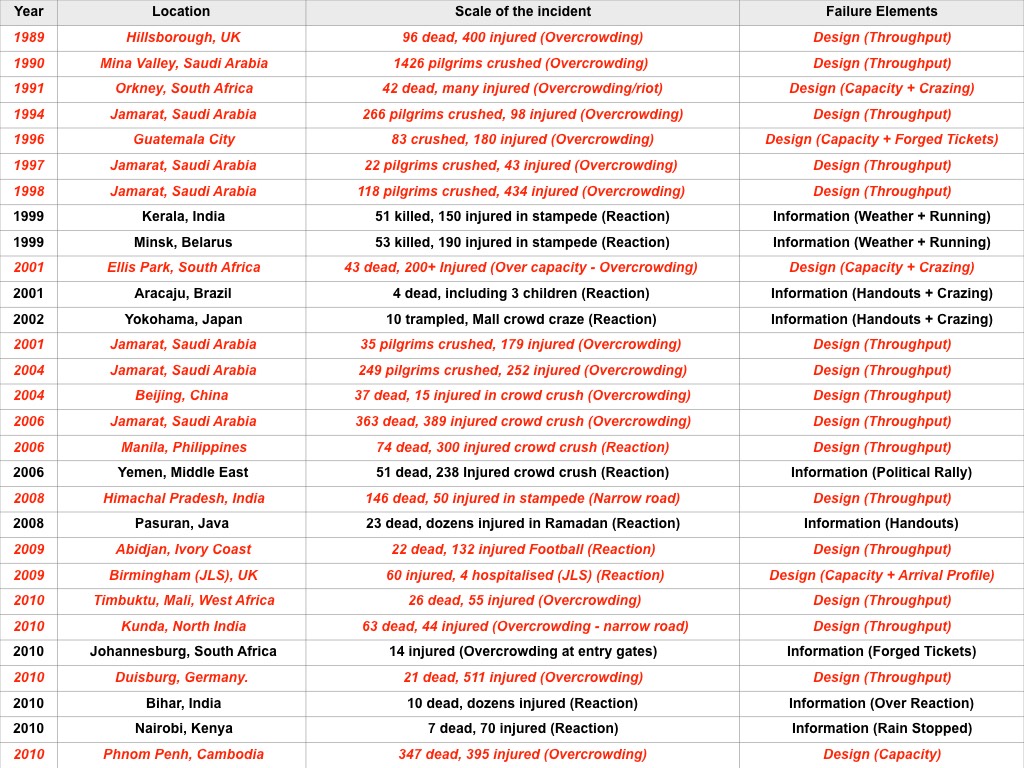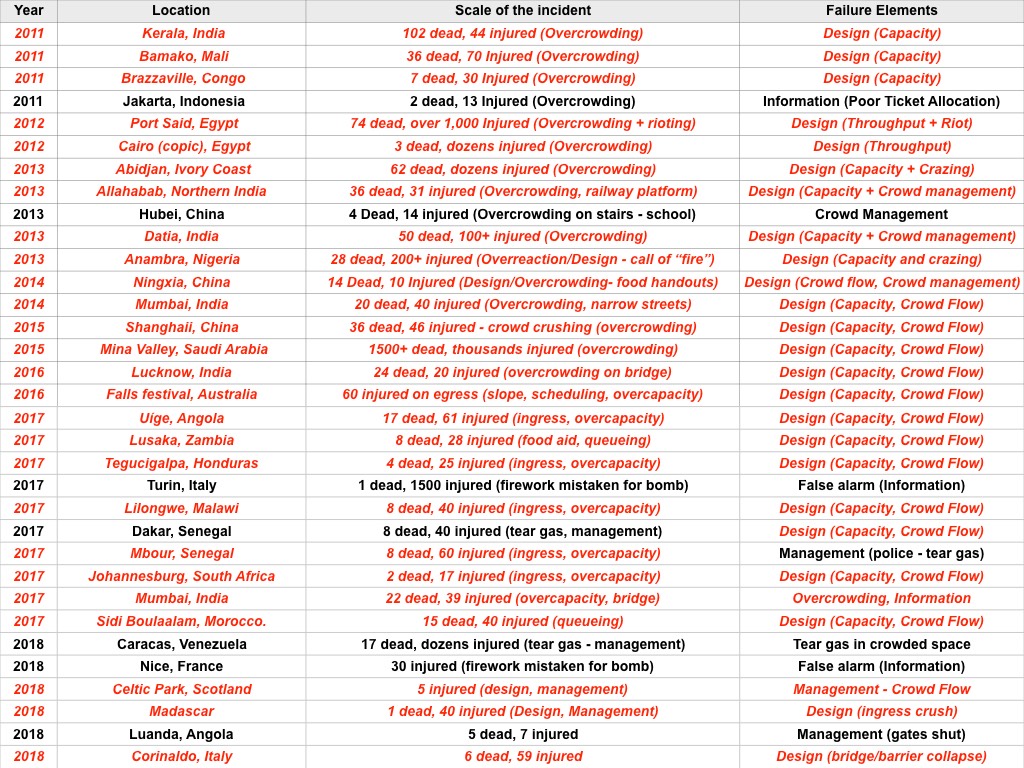_________________________________________________
Click here for information on our eLearning version of “Introduction to Crowd Science”
_________________________________________________

Chapter 2 - Crowd risk analysis (extract)
"A wise man learns by the mistakes of others, a fool by his own." (Latin Proverb)
“Human beings, who are almost unique in having the ability to learn from the experience of others, are also remarkable for their apparent disinclination to do so”. (Douglas Adams)
Introduction
One of the more interactive demonstrations we use in the workshops is a series of density experiments using a fixed area. These are important for the delegates to understand both the physical (number of people per square metre) and psychological (how it feels) factors in crowded spaces. The experiments illustrate a common failure in event planning: the temptation to focus on capacity and not on how the spaces are going to be used. We may, for example, have a vast area available for an event but still experience crowd crushing problems if the stage area is badly designed, or entry and exit systems are not suitable arranged, wide enough or have sufficient throughput capacity. Those kinds of problems can occur at pinch points in and around the event site. In this chapter, we shall build up a series of models for both static and dynamic spaces; areas where the crowd is predominantly stationary (static) and where it is predominantly moving (dynamic) to assist the event planner, licensing officer and operations teams to recognise crowd risks.
______________________________________________
Causality
If we examine the underlying causes in worldwide crowd related accidents we observe that there are some fundamental (root/distal) elements in common. In all cases accidents/incidents don't just happen - there is always a cause. Typically, the underlying cause is a lack of awareness of the problems related to crowd density and crowd flow. High density produces a interpersonal force that, if left unchecked, can be fatal. See this page for further information.
Crowd forces
"Crowd forces can reach levels that almost impossible to resist or control. Virtually all crowd deaths are due to compressive asphyxia and not the "trampling" reported by the news media. Evidence of bent steel railings after several fatal crowd incidents show that forces of more than 4500N (1,000lbs) occurred. Forces are due to pushing, and the domino effect of people leaning against each other.
"Compressive asphyxia has occurred from people being stacked up vertically, one on top of the other, or horizontal pushing and leaning forces. In the Ibrox Park soccer stadium incident, police reported that the pile of bodies was 3m (10ft) high. At this height, people on the bottom would experience chest pressures of 3600-4000N (800-900lbs), assuming half the weight of those above was concentrated in the upper body area.
"Horizontal forces sufficient to cause compressive asphyxia would be more dynamic as people push off against each other to obtain breathing space. In the Cincinnati rock concert incident, a line of bodies was found approximately 9m (30ft) from a wall near the entrance. This indicates that crowd pressures probably came from both directions as rear ranks pressed forward and front ranks pushed off the wall.
"Experiments to determine concentrated forces on guardrails due to leaning and pushing have shown that force of 30% to 75% of participant weight can occur. In a US National Bureau of Standards study of guardrails, three persons exerted a leaning force of 792N (178lbs) and 609N (137lbs) pushing. In a similar Australian Building Technology Centre study, three persons in a combined leaning an pushing posture developed a force of 1370N (306 lbs). This study showed that under a simulated "panic", 5 persons were capable of developing a force of 3430N (766lbs)." From Fruin Causes and Prevention of Crowd Disasters
Brief history of crowd disasters
Over the last 27 years there have been a number of significant crowd related disasters. Below is a short list (but not all). We reviewed the factors/elements of these disasters to understand how they occurred and how to anticipate/prepare/prevent similar incident occurring int he furtutre. The DIM-ICE risk model can be adapted to improve understanding of causality in accident/incidents and how we can develop better teaching programme to try and prevent future accidents that have similar underlying causes. That is it’s purpose, risk analysis (using the historical framework as a reference).


As we can see from the above there is a high percentage of design related disasters - these are typically where there are more people that the space can accommodate safely. Like trying to pour a quart into a pint pot….it won’t fit, it will overflow.
One of the key elements of crowd modelling is to understand the capacity of the space, how quickly it will fill and what time it will take to reach critical density. This does not need complex computer simulations as a simple first pass capacity analysis gives us clear indications whether a system will work (or needs a radical design change). In essence, if a system fails a first pass approximation, then it should be rejected and alternative solutions need to be investigated.
Crowd risks are dynamic
I've been involved in a number of expert witness cases, both UK and USA. I have also worked in Saudi Arabia (Civil Defence/Hajj projects) and specialise in crowd safety and risk analysis. Crowd risks are dynamic as the risks can change over time, sometime very quickly, often too quick to react (unless you are aware of the potential for harm). Crowd risks are dependent on a number of factors and influences. So understanding how risks change with time is fundamental to the development of a robust crowd management plan.
As I teach around the world a common theme I come across is:
We don't know how many people may come to this event?
How do we monitor/count people for large gatherings?
I've developed a few tools/techniques/methodologies - but it's really down to the basics. Planning, planning, planning!
You don't know how many people may come - first assess the maximum capacity then prepare a plan for 50% of that number, 100% of that number and 500% of that number. Compare the degrees of risk on each option. Have a SEPARATE plan for each option. Don't try and put all the plans into ONE massive book of words - break down the problems into phases (ingress-circulation-egress). Section these in an event manual, divide your event into time zones (as the event plays out different things occur). Lay out the manual like a storyboard evolving as the event would evolve. Make it a readable document. Illustrate it with site pictures and diagrams of crowd movement. Things that seem SO basic that it never fails to amaze me when I see those delegate "light bulb moments”.
Most importantly the concept of "risk" is generally considered as a value (likelihood x consequence = risk). But risk is dynamic. Risks can change with time.
When I ask the question “How do you evaluate risk?” the reply is often
"we have a consultant who does that" or
"our safety officer does that job"
Doh!
Risk management is a process from identifying the risk through to managing, reducing, or eliminating the risk. This requires risk ownership - specifically who measures, monitors, manages and mitigates your risks? Risk is not a STATIC value - it has a dynamic nature.
How do you assess different types of risks as they evolve over time?
How are you assessing the degree of risk in dynamic environments?
What metrics do you use for risk assessment?
I know that there are risks that are static (i.e.: can be assigned a single value), but do you differentiate static and dynamic risks in your environment? How to you identify these risks in your risk assessment, do you use a single value for both static and dynamic risks? Should you differentiate - if not why not?
Doesn't that seem a bit obvious?
By way of an example (from my own field of expertise) risk of trips, slips and falls is zero before an event starts (no crowds), then this risk becomes higher at the entry points (depending on terrain, numbers of people, entry system etc) then lower again (but not zero) during an event (internal crowd movement around a site) and higher again during egress. Risk of trips, slips and falls becomes suddenly very HIGH during an emergency egress.
However, typically, the risk (trips, slips and falls) only shows on risk assessment as one numerical (static) value.
There is no dimension of time and there are typically no references to specific conditions, or times as they relate to scales of this particular risk. If we consider just this simple example of trips, slips and falls - it is best described as a series of maps. I'd call that a qualitative risk map - something that I can see the location, time, duration and severity of the risk (Red, Amber, Green is sufficient) on a map. I typically produce different maps for different time, making sure that the risk is illustrated and shown as a dynamic, changing, risk.
Each map should show where the risks are in time (each map showing a different time 9am, 10am, 11am etc) and each map coloured (red-amber-green for high, medium, low) by location. I teach these basic principles to illustrate how risk can evolved, suddenly change, and it, by its very nature - dynamic....not a static value. My question to the delegates on my workshops and lectures are typically:
How do you differentiate static and dynamic risks in your environment?
How do you communicate these types of crowd risks in your risk assessment?
_______________________________________________________________
Links to modelling pages